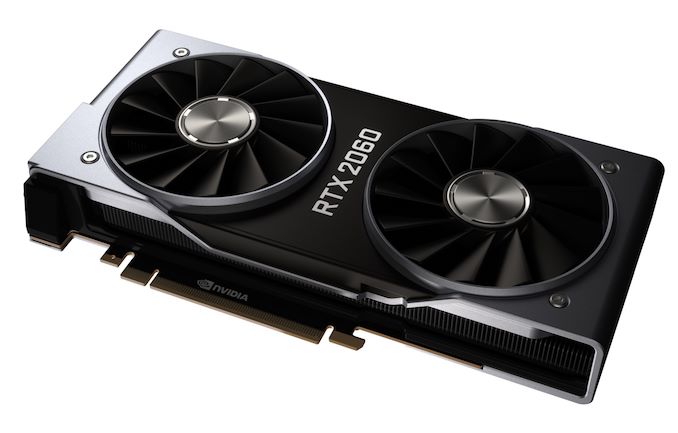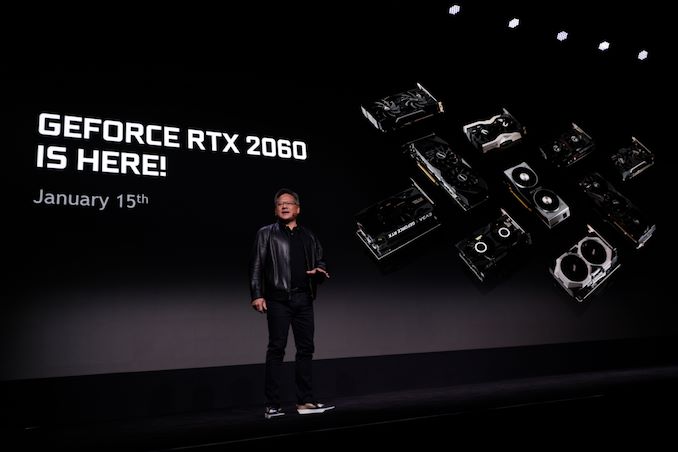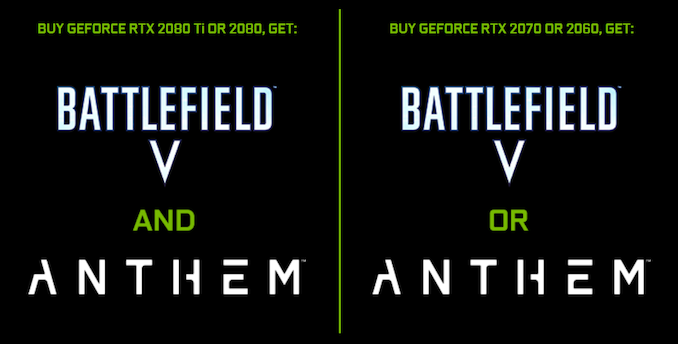The NVIDIA GeForce RTX 2060 6GB Founders Edition Review: Not Quite Mainstream
by Nate Oh on January 7, 2019 9:00 AM ESTClosing Thoughts
As we bring this to a close, we are again revisiting the central themes of the GeForce RTX 20 series across the launches: forward-looking featuresets that are not widely available, premium pricing based on those hardware features, and competition with existing Pascal products due to comparable conventional gaming performance. This time, however, the last two have played out a little differently. Pascal-based GTX 1080, 1070 Ti, and 1070s are not so readily available and/or are at higher prices. And although the price premium pushes the GeForce RTX 2060 (6GB) out of the traditional mainstream home of the x60 part, it puts it firmly in contention against the Radeon RX Vega cards and to a lesser extent the recently-launched Radeon RX 590.
As a whole, in developing Turing and the GeForce RTX 20 series, NVIDIA has invested heavily in hybrid rendering, offering less price-to-performance for conventional gaming than usual for new GPU architectures. This has been compounded by excess Pascal inventory, a result of the cryptocurrency mining demand of the past year or two. The RTX 2060 (6GB) is no exception, and while it is a better price-to-performance offering relative to its older siblings, it’s simply no longer a ‘mainstream’ video card at $350, instead occupying the ‘value-enthusiast’ space.
For conventional gaming, if the RTX 2080 is akin to the GTX 1080 Ti and the RTX 2070 like the GTX 1080, then the RTX 2060 (6GB) truly performs like the GTX 1070 Ti. By the numbers, the RTX 2060 (6GB) is 2-3% faster than the GTX 1070 Ti at 1440p and 1080p, though comparison becomes a wash at 4K. In turn, reference-to-reference the RTX 2060 (6GB) is around 11% faster than the RX Vega 56 at 1440p/1080p, narrowing to 8% at 4K. There are hints that the 6GB framebuffer might be limiting, especially with unexpectedly low 99th percentile framerates at Wolfenstein II in 4K, though nothing to the extent that older 4GB GTX 900 series cards have experienced.
Potential VRAM bottlenecks is something that needs further investigation, but more to the point, this is a $350 card featuring only 6GB VRAM. Now it is admittedly performing 14-15% ahead of the 8GB GTX 1070, a card that at MSRP was a relatively close $379, but it also means that NVIDIA has essentially regressed in VRAM capacity at this price point. In terms of the larger RTX lineup, 6GB is a bit more reasonable progression compared to the 8GB of the RTX 2070 and RTX 2080, but it is something to revisit if there are indeed lower-memory cut-down variants of the RTX 2060 on the way, or if games continue the historical path of always needing more framebuffer space. The biggest question here isn't whether it will impact the card right now, but whether 6GB will still be enough even a year down the line.
Generationally, the RTX 2060 (6GB) does bring more to the table, offering roughly 86% of the performance of the RTX 2070 for 70% of the price. Or against its direct predecessor, the GTX 1060 6GB, it’s faster by around 59%. In context, the GTX 1060 6GB was 80-85% faster than the GTX 960 (2GB) at launch, where presently that gap is more along the lines of 2X or more, with increased framebuffer the primary driver. But at $200, the GTX 960 was a true mainstream card, as was the GTX 1060 6GB at its $249 MSRP, despite the $299 Founders Edition pricing.
What makes the $350 pricing at least a bit more reasonable is its Radeon competition. Against RX Vega at its current prices the RTX 2060 (6GB) is near-lethal, so if AMD wants to keep their Vega cards as viable market competitors, they are going to have to reduce prices. Reference-to-reference, the RTX 2060 (6GB) is already bringing around 95% of RX Vega 64 performance, so card pricing will make all the difference. The same goes for the RX 590, whose position in the ‘performance gap’ between the RX Vega 56 and RX 580 is now shared. And alongside potential price changes, there are still the value-adds of game bundles and FreeSync compatibility.
At least, that would have been the straightforward case for AMD if not for yesterday’s announcement of game bundles for RTX cards, as well as ‘G-Sync Compatibility’, where NVIDIA cards will support VESA Adaptive Sync. That driver is due on the same day of the RTX 2060 (6GB) launch, and it could mean the eventual negation of AMD’s FreeSync ecosystem advantage.
Like the RTX 2070, the RTX 2060 (6GB) is less suited as an option for most high-end GTX 10 series owners, and with 6GB VRAM as it’s a little less tempting than it could be as a move up from the GTX 1060 6GB or GTX 980 Ti. The card offers known performance along the lines of the GTX 1070 Ti and at very similar power consumption, but brings better value than existing higher-end RTX 20 series models. And this time, there’s less of a spoiler effect from older Pascal models.
Compared to previous generations, it’s not breaking the price-to-performance curve, as it is still an RTX card and pulling double-duty as the new entry-point for RTX platform support. That being said, there is no mincing words about the continuing price creep of the past two GeForce series. The price-to-performance characteristics of the RTX 2070, 2080, and 2080 Ti is what renders the RTX 2060 (6GB) a better value in comparison, and not necessarily because it is great value in absolute terms. But as an upgrade from older mainstream cards, the RTX 2060 (6GB) price point is a lot more reasonable than the RTX 2070’s $500+, where there more of the price premium is from forward-looking hardware-accelerated features like realtime raytracing.
So the RTX 2060 (6GB) would be the most suitable for gamers that aren’t gung-ho early adopters or longtime enthusiasts. The caveat is on the 6GB framebuffer, keeping in mind that the 4GB GTX 980 and 970 now punch below their weight in certain games, given the trends of HDR, HD texture packs, high-refresh rates, and more. Beyond that, the RTX 2060 (6GB) and RTX 2070 comes with a choice of Anthem or Battlefield V, as part of the new bundle. For a prospective buyer, this might not justify $500 but might outweigh $350, especially as realtime raytracing can be immediately tried out with Battlefield V. In the same way, upcoming support for adaptive sync could do the same for those looking to upgrade to a monitor with variable refresh rate.













134 Comments
View All Comments
Hameedo - Monday, January 7, 2019 - link
Final Fantasy 15 already supports DLSS via a recently released patch, please correct that infobenedict - Monday, January 7, 2019 - link
Right now the Radeon RX 580 (8GB) has the best price/performance. 590, 1060 and 2060 are much more expensive but not that much faster.Hameedo - Monday, January 7, 2019 - link
The 2060 is on par with 1070Ti, it means it's much faster than 580 and 1060 (about 60%)sing_electric - Monday, January 7, 2019 - link
FWIW, the RX 580 can regularly be had for ~$200 these days, so TECHNICALLY benedict is right - the 580 goes for ~57% of the 2060's MSRP ($349) but offers more like 60-65% of the performance (and that's assuming you can find the 2060 for MSRP, which we'll have to see).IMO, they're just in different markets. The 590 is looking like a misstep by AMD at this point, since it's midway between the 580 and the 2060 in price, but isn't much faster than the 580 in real world performance. The Vega series are interesting, but AMD and partners probably have limited ability to lower prices due to how expensive the HBM2 memory on those boards is.
Bluescreendeath - Monday, January 7, 2019 - link
No, Benedict is not right. At best, he is only partially right on one out of at least three points, and only when viewed in the most favorable light. He said 1) the 2060 is "not much faster," 2) said that the 1060 is much more expensive and 3) said the 580 has the best price/performance ratio. The GTX2060 is clearly significantly faster than the RX580 (by more than 50%) so his first point is flat out wrong. His second point is also wrong because the GTX1060 costs about the same as the RX580 in terms of market price and performs about the same. His 3rd point is debateable and may be right. The 580 does have a marginally better price/performance ratio if you compare market price RX580 ($200) to MSRP GTX2060 ($350). However, if you compare MSRP RX580 ($240+) to MSRP FE GTX2060 ($350) then the equation changes as the RX580 no longer has the best price/performance either as the 2060 is 46% pricier but performs 50-60% better. And other models of the 2060 will surely be cheaper than the FE version.Ananke - Monday, January 7, 2019 - link
He is completely right - RTX2060 has 48 ROPs and 6 GB VRAM, which is pointless at $349, regardless how "fast" is the card. Raytracing is also pointless with so scarcely resourced card.At this point a person should either buy 2080Ti, if money are no object, or buy Radeon 580 8GB for under $200. Most modern games simply manage huge textures in VRAM - you need more RAM, quick memory buses and ROPs for that.
I am no particular fan, but AMD will kill NVidia any moment with announcement of 7 nm chips - at smaller process brute force will have advantage no matter how smart is NVidia's prefetch, bus compression and all other "smart" staff. Same happened to Intel. And TSMC is already occupied working for AMD, Samsung is busy and any excess is reserved by Intel, so NVidia will have no access to 7nm fab for a while
Bluescreendeath - Monday, January 7, 2019 - link
Real world results matter more than on paper specs. The actual real world benchmarks show the Gtx2060 is 50-60% faster than the rx580. You seem to be overly hung up on VRAM and ROPs. Anadtech and techspot have done plenty of tests on VRAM, and modern games dont use nearly as much VRAM as you think - even on 1440p. And take a look at the 4k benchmarks in the article. The 6Gb vram is clearly sufficient. Furthermore, the rx580 8gb costs about $200-250 new, whereas the 2060 is $350 for the more expensive founders edition. Realistically, the aftermarket cards will be something like 200-250 for new rx580s vs 300 for a new non FE 2060.As for your mention of future AMD chips, we are comparing 2060 vs 1060 vs rx580.
heavyarms1912 - Monday, January 7, 2019 - link
Reality check, RX580s 8gb can be had below $200 and even the top end aftermaket ones and with 3 game titles.wintermute000 - Monday, January 7, 2019 - link
And its what 50% slower, so what's your point?Ananke - Tuesday, January 8, 2019 - link
There are several RX580 8GB cards sales today for around $160-170. It night be old, it might be hot, but runs 1080p just perfect on any game, and it costs half.Next generation consoles are already well into making, and developers are developing games for consoles, not for PCs, which will never change since the scale of business is tenfold if not larger. Next might be game services directly integrated in the TV or whatever device gives a mass market, but would never be a PC.
Anyway, new consoles will have A LOT more VRAM, and 6GB will simply not cut it. And they are coming later this year/early next year, not like waiting ten years for it. I have lived through enough NVidia "cycles" and can tell you this is typical NVidia greed - narrow memory bus and limited memory - exactly like 12 years ago, when AMD had nothing, but came with the rough, hot unoptimized 5850 and collected half of the market.
The card is OK, it is just not worth $350 today, that's my point.